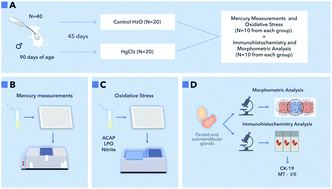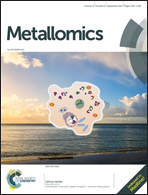Chronic exposure to inorganic mercury induces biochemical and morphological changes in the salivary glands of rats
Abstract
Mercury exposure is considered to be a public health problem due to the generation of toxic effects on human health as a result of environmental and occupational conditions. The inorganic form of mercury (HgCl2) can cause several biological changes in cells and tissues through its cumulative toxic potential, but little has been experimentally proven about the effects of inorganic mercury on salivary glands, an important modulator organ of oral health. This study analyzes the effects of prolonged low dose exposure to HgCl2 on the salivary glands of rats. Adult animals received a dose of 0.375 mg kg−1 day−1 over a period of 45 days. The parotid and submandibular glands were collected for analysis of the mercury levels and evaluation of oxidative stress, histological parameters and immunomodulation for metallothionein I and II (MT-I/II). In this investigation, biochemical and tissue changes in the salivary glands were verified due to the mercury levels, causing reduction in antioxidant capacity against peroxyl radicals, with consequent cellular lipid peroxidation and an increase in nitrite levels, volumetric changes and cytoskeletal damage in the submandibular glands, with less severe damage to the parotid glands. The results also have shown the occurrence of a cytoprotection mechanism due to increased MT-I/II expression, but not enough to avoid the morphology and oxidative damage. This evidence highlights, for the first time, that inorganic mercury is able to alter the morphology and oxidative biochemistry in salivary glands when exposed for a long time in low doses.



 Please wait while we load your content...
Please wait while we load your content...